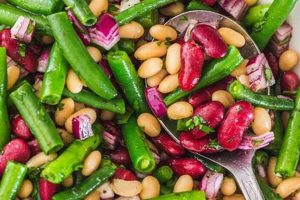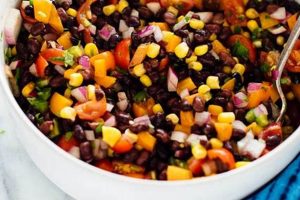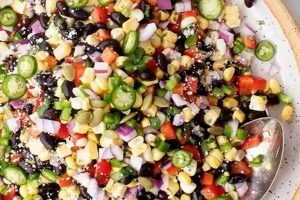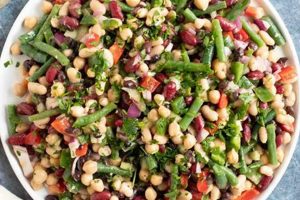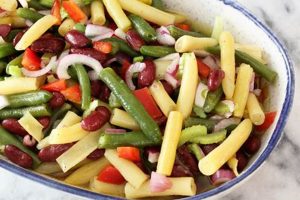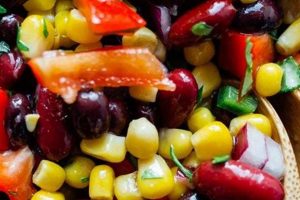A dish combining cooked black beans, quinoa, and typically other ingredients like chopped vegetables, herbs, and a flavorful dressing creates a nutritious and versatile meal. For instance, a simple version might include corn, red onion, cilantro, and a lime vinaigrette. Variations can incorporate ingredients like bell peppers, avocado, tomatoes, or roasted sweet potatoes, allowing for diverse flavor profiles and catering to individual preferences.
This type of salad offers a complete protein source, combining the amino acid profiles of legumes and grains. It is also rich in fiber, promoting digestive health and satiety. Furthermore, the inherent flexibility of the dish allows for adaptation to seasonal ingredients and dietary restrictions, making it a popular choice for healthy eating. Historically, quinoa has been a staple in Andean cultures for centuries, while black beans have been a dietary cornerstone in various regions across the Americas. The modern combination of these ingredients reflects a growing appreciation for globally inspired cuisine and nutrient-dense meals.
The following sections will explore specific variations of this culinary concept, providing detailed instructions and nutritional information to guide readers in creating their own delicious and healthful versions.
Tips for Creating Delicious and Nutritious Combinations
Optimizing ingredient selection and preparation techniques enhances the flavor and nutritional value of the dish. Attention to detail ensures a satisfying culinary experience.
Tip 1: Rinse the Quinoa: Rinsing quinoa under cold water before cooking removes its natural coating of saponins, which can impart a bitter flavor.
Tip 2: Cook Quinoa Properly: Use a 2:1 ratio of water to quinoa for optimal texture. Bring the water to a boil, add the quinoa, reduce heat, cover, and simmer for 15 minutes, or until all the water is absorbed.
Tip 3: Use Canned or Dried Beans: Canned black beans offer convenience, while dried beans provide a deeper flavor. If using dried beans, soak them overnight and cook them thoroughly before adding them to the salad.
Tip 4: Enhance Flavor with Fresh Herbs: Incorporating fresh herbs like cilantro, parsley, or mint elevates the flavor profile. Add herbs just before serving to maximize their freshness.
Tip 5: Balance the Dressing: A well-balanced dressing complements the other ingredients. Consider a vinaigrette with a citrus element, such as lime or lemon juice, combined with olive oil and seasonings.
Tip 6: Add Texture with Roasted Vegetables: Roasted vegetables like sweet potatoes, bell peppers, or corn add depth of flavor and textural contrast.
Tip 7: Consider Toasted Nuts and Seeds: Toasted nuts or seeds, such as pepitas or sunflower seeds, provide additional crunch and nutritional value.
By following these tips, one can create a balanced and flavorful dish maximizing both taste and nutritional benefits. Careful preparation and ingredient selection are key to a truly satisfying culinary outcome.
The following section will offer several recipe variations, incorporating these tips to illustrate their practical application.
1. Ingredients
Ingredient selection significantly impacts the nutritional value, flavor profile, and overall quality of a black bean and quinoa salad. Careful consideration of each component contributes to a well-balanced and satisfying dish.
- Base Ingredients:
Black beans and quinoa form the foundational elements, providing protein, fiber, and complex carbohydrates. The variety of quinoa (e.g., red, white, black) can influence the texture and visual appeal. Similarly, using canned versus dried black beans impacts preparation time and flavor nuances.
- Vegetables:
Fresh vegetables contribute vitamins, minerals, and texture. Common additions include diced bell peppers, chopped red onion, corn kernels, and cherry tomatoes. Roasting vegetables like sweet potatoes or zucchini before adding them to the salad can enhance their flavor and create textural contrast.
- Herbs and Spices:
Fresh herbs like cilantro, parsley, or mint provide brightness and aromatic complexity. Spices such as cumin, chili powder, or smoked paprika can add depth and warmth to the flavor profile. The selection should complement the other ingredients and create a balanced taste.
- Dressing:
The dressing binds the ingredients and contributes significantly to the overall flavor. A simple vinaigrette made with olive oil, lime juice, and seasonings is a popular choice. Variations can include adding ingredients like Dijon mustard, honey, or tahini for different flavor profiles.
The synergistic combination of these ingredient categories determines the final character of the salad. A thoughtful approach to ingredient selection ensures a nutritious, flavorful, and visually appealing dish.
2. Preparation
Proper preparation techniques are essential for optimizing the texture, flavor, and overall quality of a black bean and quinoa salad. Each step, from cooking the quinoa to combining the ingredients, contributes to the final result. Attention to detail ensures a successful and enjoyable culinary experience.
- Cooking the Quinoa:
Rinsing the quinoa before cooking removes any residual saponins, which can impart a bitter taste. The quinoa should be cooked according to package directions, typically using a 2:1 ratio of water to quinoa. Proper cooking ensures a light and fluffy texture, avoiding a mushy or crunchy consistency.
- Preparing the Black Beans:
Canned black beans should be rinsed and drained to remove excess sodium and canning liquid. If using dried beans, they require soaking overnight and then cooking until tender. Thorough cooking ensures optimal digestibility and flavor.
- Chopping Vegetables and Herbs:
Uniformly chopping vegetables ensures even distribution throughout the salad and consistent flavor in each bite. Fresh herbs should be chopped just before serving to maximize their flavor and aroma. Consistent sizing contributes to both visual appeal and balanced flavor distribution.
- Preparing the Dressing:
The dressing should be prepared in a separate bowl and emulsified to combine the ingredients thoroughly. The balance of acidity, oil, and seasonings significantly impacts the overall flavor profile. Proper emulsification creates a cohesive and flavorful dressing that coats the salad ingredients evenly.
Careful execution of these preparatory steps ensures a well-balanced and flavorful black bean and quinoa salad. Attention to detail in each stage of preparation contributes significantly to the final quality and enjoyment of the dish.
3. Flavor Profiles
Flavor profiles play a crucial role in the overall success of a black bean and quinoa salad recipe. The inherent versatility of the dish allows for a wide range of flavor combinations, from bright and citrusy to earthy and savory. A well-developed flavor profile elevates the salad from a simple combination of ingredients to a complex and satisfying culinary experience. The interplay of sweet, sour, salty, bitter, and umami elements creates depth and balance. For example, the sweetness of roasted corn can be balanced by the acidity of lime juice, while the earthiness of black beans can be complemented by the freshness of cilantro and the bite of red onion. The careful orchestration of these flavors creates a harmonious and memorable dish.
Understanding the impact of individual ingredients on the overall flavor profile allows for customization and creativity. Adding ingredients like cumin, chili powder, or smoked paprika introduces warm and smoky notes, while incorporating fresh herbs like mint or parsley adds brightness and complexity. The choice of dressing also plays a significant role. A citrus vinaigrette provides a tangy counterpoint to the earthiness of the beans and quinoa, while a creamy avocado dressing adds richness and a subtle nuttiness. The flavor profile should be tailored to individual preferences and the desired overall effect. A vibrant and refreshing salad might feature citrus and herbs, while a heartier and more robust salad might incorporate roasted vegetables and spices.
Successful flavor profile development requires a balance of complementary and contrasting elements. Achieving this balance enhances the sensory experience and elevates the dish beyond its basic components. The interplay of flavors stimulates the palate and creates a more satisfying and memorable meal. Consideration of the interplay of ingredients and their individual contributions to the overall flavor profile is essential for creating a successful and enjoyable black bean and quinoa salad.
4. Nutritional Value
Nutritional value represents a significant advantage of a black bean and quinoa salad recipe. This dish offers a dense combination of essential nutrients derived from its core components. Quinoa, a complete protein source, provides all nine essential amino acids crucial for muscle building and repair. It also contributes iron and magnesium. Black beans, another excellent source of protein, are rich in dietary fiber, promoting digestive health and satiety. They also offer folate and potassium. The combination creates a synergistic nutritional powerhouse, offering a balanced profile beneficial for overall well-being. For instance, a single serving can contribute significantly to daily fiber and protein requirements, supporting weight management and sustained energy levels. The presence of complex carbohydrates provides sustained energy release, avoiding blood sugar spikes.
Beyond the core ingredients, the nutritional profile can be further enhanced by incorporating various vegetables. Adding ingredients like bell peppers contributes vitamin C and antioxidants, while leafy greens offer vitamin K and other micronutrients. The nutritional value of the salad directly correlates with the variety and quality of incorporated ingredients. Choosing fresh, seasonal produce maximizes nutrient density. Furthermore, the dressing choice impacts overall nutritional composition. Opting for a vinaigrette made with olive oil provides healthy fats and avoids added sugars commonly found in processed dressings. Understanding these nutritional nuances allows for informed choices that maximize health benefits. For example, substituting roasted sweet potatoes for croutons adds vitamins and reduces processed carbohydrates. Thoughtful ingredient selection elevates the nutritional impact of this versatile dish.
In conclusion, the nutritional value inherent in a black bean and quinoa salad provides a substantial benefit. Combining complete proteins, complex carbohydrates, fiber, vitamins, and minerals creates a nutrient-dense meal option suitable for a variety of dietary needs. Understanding the nutritional contribution of each component allows for informed choices that maximize health benefits while maintaining culinary appeal. This awareness empowers individuals to create a meal that not only satisfies hunger but also contributes to long-term well-being. Challenges such as sodium content in canned beans can be mitigated through rinsing or opting for low-sodium varieties. Integrating this understanding into recipe development enhances the practical application of nutritional knowledge in everyday meal planning.
5. Dietary Adaptations
Dietary adaptations are crucial when considering a black bean and quinoa salad recipe due to its inherent versatility. The dish readily accommodates various dietary restrictions and preferences, making it an inclusive culinary option. Understanding these adaptations ensures the recipe remains accessible and enjoyable for a wider audience. This adaptability stems from the foundational ingredients and their potential modifications.
- Vegetarian and Vegan Diets:
The recipe inherently aligns with vegetarian and vegan diets as it centers around plant-based proteins and whole grains. This natural compatibility eliminates the need for substitutions or omissions, maintaining the integrity of the original recipe. The avoidance of animal products simplifies ingredient sourcing and preparation for those adhering to these dietary principles. The nutritional completeness of the combined quinoa and black beans provides essential amino acids often lacking in single-source plant proteins.
- Gluten-Free Diets:
Quinoa, a naturally gluten-free grain, makes this salad suitable for individuals avoiding gluten. Careful selection of other ingredients, ensuring they are also gluten-free, maintains the dishs suitability for these dietary needs. Cross-contamination during preparation should be avoided. This adaptation requires awareness of potential hidden gluten sources in ingredients like dressings or spice blends. Using certified gluten-free products mitigates this risk.
- Low-Sodium Diets:
Sodium content can be managed by thoroughly rinsing canned beans and utilizing low-sodium or no-salt-added varieties. Controlling sodium levels in the dressing also contributes to making the salad suitable for those monitoring sodium intake. Fresh herbs and spices can be used to enhance flavor without relying on salt. This adaptation is crucial for individuals managing conditions like hypertension.
- Food Allergies and Intolerances:
The recipes flexibility allows for substitutions to accommodate specific food allergies or intolerances. For example, individuals with corn allergies can omit corn or substitute it with another vegetable like diced bell peppers. Awareness of potential allergens in all ingredients, including the dressing, is essential for safe consumption. Clear communication regarding ingredients used is vital when serving this dish to others.
These dietary adaptations highlight the inherent inclusivity of the black bean and quinoa salad. Its adaptability ensures it can be enjoyed by a wide range of individuals with diverse dietary requirements. Thoughtful consideration of these adaptations expands the recipes appeal and promotes its potential as a healthful and versatile meal option. By understanding these modifications, the dish remains a nutritious and accessible choice for various dietary preferences, furthering its value in promoting healthy eating patterns across diverse populations.
6. Serving Suggestions
Serving suggestions enhance the versatility and enjoyment of a black bean and quinoa salad recipe. Understanding how this dish integrates into various meal structures maximizes its appeal and practicality. Appropriate serving suggestions transform a standalone salad into a component of a more comprehensive dining experience. This understanding elevates the recipe beyond a simple set of instructions, providing context for its consumption. For example, the salad can serve as a light yet complete lunch, accompanied by a side of whole-grain bread or crackers. Its adaptability allows it to function as a side dish alongside grilled chicken or fish, providing a nutritious and flavorful counterpoint to richer protein sources. Furthermore, the salad can be incorporated into larger meals, such as buffets or potlucks, offering a refreshing and healthful option among other dishes.
Practical applications of serving suggestions depend on the specific context. For a casual weeknight dinner, the salad might be served as a main course with a dollop of plain yogurt or a sprinkle of feta cheese for added protein and flavor. In a more formal setting, it could be presented as an appetizer in individual portions, garnished with edible flowers or microgreens for an elegant touch. For meal prepping, dividing the salad into individual containers allows for convenient grab-and-go lunches throughout the week. Consideration of portion sizes and accompanying elements, like dressings or garnishes, further refines the serving approach. Modifying serving sizes based on the intended role of the salad within a meal ensures appropriate balance and satiety. Accompanying elements like toasted nuts, seeds, or a drizzle of olive oil can enhance both flavor and visual appeal.
Effective serving suggestions maximize the potential of a black bean and quinoa salad recipe. Integrating this understanding into recipe development expands its practical application and enhances its appeal to a wider audience. Challenges such as maintaining freshness and preventing sogginess when serving as part of a buffet can be addressed by serving the dressing on the side and adding easily wilted ingredients like avocado just before serving. This attention to detail elevates the dining experience and reinforces the value of considering serving suggestions as an integral part of recipe development.
7. Storage Techniques
Storage techniques significantly impact the quality and safety of a black bean and quinoa salad. Proper storage preserves freshness, flavor, and texture while mitigating the risk of bacterial growth. Understanding these techniques is crucial for maximizing the shelf life of prepared salads and ensuring safe consumption. The high moisture content and perishable nature of several ingredients necessitate careful storage practices. Improper storage can lead to undesirable outcomes such as textural degradation, flavor deterioration, and potential foodborne illness. For instance, storing the salad at room temperature for extended periods encourages bacterial proliferation, posing a health risk. Conversely, proper refrigeration inhibits bacterial growth and maintains the quality of the ingredients.
Effective storage involves utilizing airtight containers and appropriate refrigeration temperatures. Storing the salad components separately, particularly the dressing, helps maintain optimal texture and prevents the salad from becoming soggy. Consuming the salad within a recommended timeframe, typically three to five days, further ensures quality and safety. Practical applications vary depending on individual circumstances. For meal preppers, dividing the salad into individual portions in airtight containers facilitates convenient storage and consumption throughout the week. For larger batches, utilizing shallow containers for refrigeration promotes even cooling and prevents spoilage. Addressing challenges such as limited refrigerator space can involve strategic planning of meal preparation and consumption schedules. Freezing, while possible, can alter the texture of certain vegetables, impacting the overall quality of the salad upon thawing. Therefore, refrigeration remains the preferred method for short-term storage.
In conclusion, appropriate storage techniques are essential for preserving the quality and safety of a black bean and quinoa salad. Careful attention to storage practices maximizes shelf life, prevents spoilage, and mitigates health risks. Integrating this understanding into meal preparation routines ensures optimal enjoyment and safe consumption of this nutritious and versatile dish. This awareness empowers individuals to maximize the value of their culinary efforts while prioritizing food safety and minimizing food waste. By consistently applying these techniques, individuals can confidently enjoy the benefits of this healthful meal option without compromising quality or safety.
Frequently Asked Questions
This section addresses common inquiries regarding black bean and quinoa salad recipes, providing concise and informative responses to clarify potential uncertainties and enhance understanding of key aspects related to preparation, storage, and variations.
Question 1: How long can this salad be stored in the refrigerator?
Properly stored in an airtight container, the salad typically maintains optimal quality for three to five days in the refrigerator. Beyond this timeframe, quality may degrade, and the risk of spoilage increases.
Question 2: Can this salad be frozen?
While freezing is possible, it’s generally not recommended. Freezing can alter the texture of certain vegetables, compromising the overall quality upon thawing. Refrigeration remains the preferred storage method.
Question 3: What can be substituted for black beans?
Kidney beans, pinto beans, or chickpeas offer suitable alternatives to black beans, providing similar nutritional profiles and textures. The choice of substitute may influence the overall flavor profile.
Question 4: Is it necessary to rinse quinoa before cooking?
Rinsing quinoa before cooking is highly recommended. This process removes the naturally occurring coating of saponins, which can impart a bitter flavor to the cooked quinoa.
Question 5: Can the dressing be made ahead of time?
Dressing can be prepared in advance and stored separately in an airtight container in the refrigerator. Adding the dressing just before serving helps maintain the salad’s optimal texture.
Question 6: How can sodium content be reduced?
Sodium content can be minimized by using low-sodium or no-salt-added canned beans, rinsing canned beans thoroughly, and controlling sodium levels in the dressing. Fresh herbs and spices enhance flavor without relying on added salt.
Careful consideration of these frequently asked questions enhances understanding and facilitates successful preparation and enjoyment of black bean and quinoa salads. These insights provide practical guidance for maximizing quality, flavor, and safety.
For further exploration of specific recipe variations and detailed nutritional information, please consult the following resources.
Black Bean and Quinoa Salad Recipe
This exploration of black bean and quinoa salad recipes has provided a comprehensive overview of this versatile dish. Key aspects, from ingredient selection and preparation techniques to nutritional value and dietary adaptations, have been thoroughly examined. Emphasis has been placed on understanding the interplay of flavors, the importance of proper storage, and the adaptability of this recipe to diverse dietary needs and preferences. The versatility of this dish allows for creative exploration of flavor profiles, while its nutritional density contributes to a balanced and healthful meal option.
The adaptability of black bean and quinoa salad recipes positions them as a valuable component of a diverse and health-conscious diet. Continued exploration of ingredient combinations and flavor profiles promises further culinary innovation. Understanding the principles outlined herein empowers individuals to create nutritious, flavorful, and personalized versions of this adaptable dish, contributing to a more informed and healthful approach to culinary practices.

